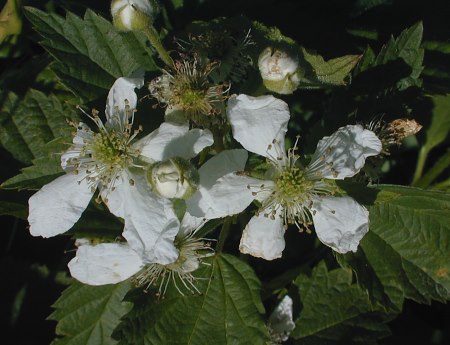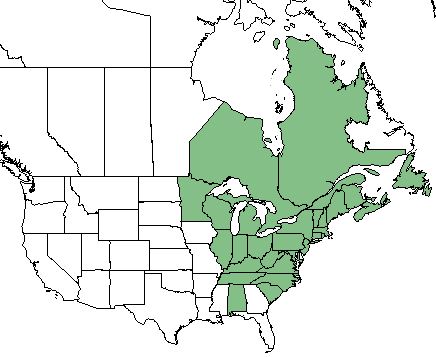Difference between revisions of "Rubus pensilvanicus"
Rwagner914 (talk | contribs) (Created page with "{{subst:Template:PlantName}}") |
HaleighJoM (talk | contribs) (→Ecology) |
||
| (22 intermediate revisions by 7 users not shown) | |||
| Line 1: | Line 1: | ||
{{italic title}} | {{italic title}} | ||
| + | Common name: Pennsylvania blackberry<ref name= "Weakley 2015"/>, eastern blackberry<ref name= "Weakley 2015"/> | ||
<!-- Get the taxonomy information from the NRCS Plants database --> | <!-- Get the taxonomy information from the NRCS Plants database --> | ||
{{taxobox | {{taxobox | ||
| − | | name = | + | | name = Rubus pensilvanicus |
| − | | image = | + | | image = Rubus_pensilvanicus_IWF.jpg |
| − | | image_caption = Photo by | + | | image_caption = Photo by John Hilty hosted at [http://www.illinoiswildflowers.info/savanna/plants/pa_blackberry.htm IllinoisWildflowers.info] |
| regnum = Plantae | | regnum = Plantae | ||
| divisio = Magnoliophyta - Flowering plants | | divisio = Magnoliophyta - Flowering plants | ||
| − | | classis = | + | | classis = Magnoliopsida - Dicots |
| − | | ordo = | + | | ordo = Rosales |
| − | | familia = | + | | familia = Rosaceae |
| − | | genus = '' | + | | genus = ''Rubus'' |
| − | | species = ''''' | + | | species = '''''R. pensilvanicus''''' |
| − | | binomial = '' | + | | binomial = ''Rubus pensilvanicus '' |
| − | | binomial_authority = | + | | binomial_authority = Poir. |
| − | | range_map = | + | | range_map = RUBU_PENS_DIST.JPG |
| − | | range_map_caption = Natural range of '' | + | | range_map_caption = Natural range of ''Rubus pensilvanicus'' from USDA NRCS [https://plants.usda.gov/core/profile?symbol=RUPE3 Plants Database]. |
}} | }} | ||
==Taxonomic Notes== | ==Taxonomic Notes== | ||
| + | Synonyms: ''R. argutus''; ''R. andrewsianus'' Blanchard; ''R. barbarus'' L.H. Bailey; ''R. bellobatus'' L.H. Bailey; ''R. betulifolius'' Small; ''R. blakei'' L.H. Bailey; ''R. condensiflorus'' L.H. Bailey; ''R. congruus'' Bailey; ''R. cupressorum'' Fernald; ''R. defectionis'' Fernald; ''R. densissimus'' H.A. Davis & T. Davis; ''R. dissitiflorus'' Fernald; ''R. fatuus'' Bailey; ''R. floricomus'' Blanchard; ''R. floridus'' Trattinick; ''R. frondosus'' Bigelow; ''R. immanis'' L.H. Bailey; ''R. jennisonii'' L.H. Bailey; ''R. jugosus'' L.H. Bailey; ''R. laudatus'' Berger; ''R. leggii'' H.A. Davis & T. Davis; ''R. libratus'' L.H. Bailey; 'R. louisianus'' Berger; ''R. orarius'' Blanchard; ''R. ostryifolius'' Rydberg; ''R. pauxillus'' L.H. Bailey; ''R. pergratus'' Blanchard; ''R. philadelphicus'' Blanchard; ''R. praepes'' L.H. Bailey; ''R. prestonensis'' H.A. Davis & T. Davis; ''R. recurvans'' Blanchard; ''R. rosarius'' L.H. Bailey; ''R. subsolanus'' L.H. Bailey; ''R. tygartensis'' H.A. Davis & T. Davis | ||
| + | |||
| + | Varieties: none | ||
| + | |||
==Description== | ==Description== | ||
<!-- Basic life history facts such as annual/perrenial, monoecious/dioecious, root morphology, seed type, etc. --> | <!-- Basic life history facts such as annual/perrenial, monoecious/dioecious, root morphology, seed type, etc. --> | ||
| + | ''R. pensilvanicus'' is a perennial subshrub of the ''Rosaceae'' family native to North America and Canada.<ref name= "USDA Plant Database"> USDA Plant Database [https://plants.usda.gov/core/profile?symbol=RUPE3 https://plants.usda.gov/core/profile?symbol=RUPE3] </ref> | ||
| + | |||
==Distribution== | ==Distribution== | ||
| + | ''R. pensilvanicus'' is found in the eastern half of the United States from Minnesota to Maine, as well as the Ontario, Quebec, New Brunswick, Nova Scotia, and Newfoundland/Labrador regions of Canada.<ref name= "USDA Plant Database"/> | ||
| + | |||
==Ecology== | ==Ecology== | ||
===Habitat=== <!--Natural communities, human disturbed habitats, topography, hydrology, soils, light, fire regime requirements for removal of competition, etc.--> | ===Habitat=== <!--Natural communities, human disturbed habitats, topography, hydrology, soils, light, fire regime requirements for removal of competition, etc.--> | ||
| − | < | + | ''R. pensilvanicus'' proliferates in roadsides, thickets, and woodlands.<ref name= "Weakley 2015"> Weakley, A. S. (2015). Flora of the Southern and Mid-Atlantic States. Chapel Hill, NC, University of North Carolina Herbarium. </ref> Specimens have been collected from vacant lots, river floodplain, shallow waters, floodplain forests, planted slash pine plantation, open pasture, swampy woodland, thicket bordering marsh, bottomland woodland, edge of pine wood, bayside hammock, saw grass savanna, , and along small streams.<ref name = "FSU herbarium"> URL: http://herbarium.bio.fsu.edu. Last accessed: June 2018. Collectors: Sara J. Noyes, Loran Anderson, R.K. Godfrey, R. Kral, Sidney McDaniel, O. Lakela, D.B. Ward, L. B. Trott, Robert Lazor, K.M. Meyer, A. Townesmith, Lisa Keppner, Ed. Keppner, Kyle Shankle, William Platt. States and counties: Florida (Leon, Wakulla, Taylor, Liberty, Sumter, Jefferson, Gadsden, Polk, Levy, Gulf, Franklin, Bay, Holmes) Georgia (Thomas)</ref> |
| + | |||
| + | ===Phenology=== <!--Timing off flowering, fruiting, seed dispersal, and environmental triggers. Cite PanFlora website if appropriate: http://www.gilnelson.com/PanFlora/ --> | ||
| + | ''R. pensilvanicus'' has been observed to flower February through May.<ref name= "PanFlora"> Nelson, G. PanFlora: Plant data for the eastern United States with emphasis on the Southeastern Coastal Plains, Florida, and the Florida Panhandle. www.gilnelson.com/PanFlora/ Accessed: 29 MAY 2018 </ref> | ||
<!--===Seed dispersal===--> | <!--===Seed dispersal===--> | ||
<!--===Seed bank and germination===--> | <!--===Seed bank and germination===--> | ||
| − | + | ===Fire ecology=== <!--Fire tolerance, fire dependence, adaptive fire responses--> | |
| + | Populations of ''Rubus pensilvanicus'' have been known to persist through repeated annual burns.<ref>Robertson, K.M. Unpublished data collected from Pebble Hill Fire Plots, Pebble Hill Plantation, Thomasville, Georgia.</ref><ref>Platt, W.J., R. Carter, G. Nelson, W. Baker, S. Hermann, J. Kane, L. Anderson, M. Smith, K. Robertson. 2021. Unpublished species list of Wade Tract old-growth longleaf pine savanna, Thomasville, Georgia.</ref> | ||
<!--===Pollination===--> | <!--===Pollination===--> | ||
| − | <!--=== | + | <!--===Herbivory and toxicology===<!--Common herbivores, granivory, insect hosting, poisonous chemicals, allelopathy, etc--> |
| − | <!--==Diseases and parasites==--> | + | <!--===Diseases and parasites===--> |
| + | |||
| + | ==Conservation, cultivation, and restoration== | ||
| + | |||
| + | ==Cultural use== | ||
| + | Historically, in Appalachia, tea from the roots was used to treat cold symptoms, and the same tea or juice from the fruit was used to cure dysentery.<ref> Korchmal, Arnold & Connie. 1973. A Guide to the Medicinal Plants of the United States. The New York Times Book Company, New York.</ref> | ||
| − | + | The entire plant can be consumed in various ways, but the fruits are especially popular to eat fresh or to make jellies and drinks.<ref> Fernald, et al. 1958. Edible Plants of Eastern North America. Harper and Row Publishers, New York.</ref> | |
| − | |||
==Photo Gallery== | ==Photo Gallery== | ||
<gallery widths=180px> | <gallery widths=180px> | ||
</gallery> | </gallery> | ||
==References and notes== | ==References and notes== | ||
Latest revision as of 15:29, 15 July 2022
Common name: Pennsylvania blackberry[1], eastern blackberry[1]
| Rubus pensilvanicus | |
|---|---|

| |
| Photo by John Hilty hosted at IllinoisWildflowers.info | |
| Scientific classification | |
| Kingdom: | Plantae |
| Division: | Magnoliophyta - Flowering plants |
| Class: | Magnoliopsida - Dicots |
| Order: | Rosales |
| Family: | Rosaceae |
| Genus: | Rubus |
| Species: | R. pensilvanicus |
| Binomial name | |
| Rubus pensilvanicus Poir. | |

| |
| Natural range of Rubus pensilvanicus from USDA NRCS Plants Database. | |
Contents
Taxonomic Notes
Synonyms: R. argutus; R. andrewsianus Blanchard; R. barbarus L.H. Bailey; R. bellobatus L.H. Bailey; R. betulifolius Small; R. blakei L.H. Bailey; R. condensiflorus L.H. Bailey; R. congruus Bailey; R. cupressorum Fernald; R. defectionis Fernald; R. densissimus H.A. Davis & T. Davis; R. dissitiflorus Fernald; R. fatuus Bailey; R. floricomus Blanchard; R. floridus Trattinick; R. frondosus Bigelow; R. immanis L.H. Bailey; R. jennisonii L.H. Bailey; R. jugosus L.H. Bailey; R. laudatus Berger; R. leggii H.A. Davis & T. Davis; R. libratus L.H. Bailey; 'R. louisianus Berger; R. orarius Blanchard; R. ostryifolius Rydberg; R. pauxillus L.H. Bailey; R. pergratus Blanchard; R. philadelphicus Blanchard; R. praepes L.H. Bailey; R. prestonensis H.A. Davis & T. Davis; R. recurvans Blanchard; R. rosarius L.H. Bailey; R. subsolanus L.H. Bailey; R. tygartensis H.A. Davis & T. Davis
Varieties: none
Description
R. pensilvanicus is a perennial subshrub of the Rosaceae family native to North America and Canada.[2]
Distribution
R. pensilvanicus is found in the eastern half of the United States from Minnesota to Maine, as well as the Ontario, Quebec, New Brunswick, Nova Scotia, and Newfoundland/Labrador regions of Canada.[2]
Ecology
Habitat
R. pensilvanicus proliferates in roadsides, thickets, and woodlands.[1] Specimens have been collected from vacant lots, river floodplain, shallow waters, floodplain forests, planted slash pine plantation, open pasture, swampy woodland, thicket bordering marsh, bottomland woodland, edge of pine wood, bayside hammock, saw grass savanna, , and along small streams.[3]
Phenology
R. pensilvanicus has been observed to flower February through May.[4]
Fire ecology
Populations of Rubus pensilvanicus have been known to persist through repeated annual burns.[5][6]
Conservation, cultivation, and restoration
Cultural use
Historically, in Appalachia, tea from the roots was used to treat cold symptoms, and the same tea or juice from the fruit was used to cure dysentery.[7]
The entire plant can be consumed in various ways, but the fruits are especially popular to eat fresh or to make jellies and drinks.[8]
Photo Gallery
References and notes
- ↑ 1.0 1.1 1.2 Weakley, A. S. (2015). Flora of the Southern and Mid-Atlantic States. Chapel Hill, NC, University of North Carolina Herbarium.
- ↑ 2.0 2.1 USDA Plant Database https://plants.usda.gov/core/profile?symbol=RUPE3
- ↑ URL: http://herbarium.bio.fsu.edu. Last accessed: June 2018. Collectors: Sara J. Noyes, Loran Anderson, R.K. Godfrey, R. Kral, Sidney McDaniel, O. Lakela, D.B. Ward, L. B. Trott, Robert Lazor, K.M. Meyer, A. Townesmith, Lisa Keppner, Ed. Keppner, Kyle Shankle, William Platt. States and counties: Florida (Leon, Wakulla, Taylor, Liberty, Sumter, Jefferson, Gadsden, Polk, Levy, Gulf, Franklin, Bay, Holmes) Georgia (Thomas)
- ↑ Nelson, G. PanFlora: Plant data for the eastern United States with emphasis on the Southeastern Coastal Plains, Florida, and the Florida Panhandle. www.gilnelson.com/PanFlora/ Accessed: 29 MAY 2018
- ↑ Robertson, K.M. Unpublished data collected from Pebble Hill Fire Plots, Pebble Hill Plantation, Thomasville, Georgia.
- ↑ Platt, W.J., R. Carter, G. Nelson, W. Baker, S. Hermann, J. Kane, L. Anderson, M. Smith, K. Robertson. 2021. Unpublished species list of Wade Tract old-growth longleaf pine savanna, Thomasville, Georgia.
- ↑ Korchmal, Arnold & Connie. 1973. A Guide to the Medicinal Plants of the United States. The New York Times Book Company, New York.
- ↑ Fernald, et al. 1958. Edible Plants of Eastern North America. Harper and Row Publishers, New York.